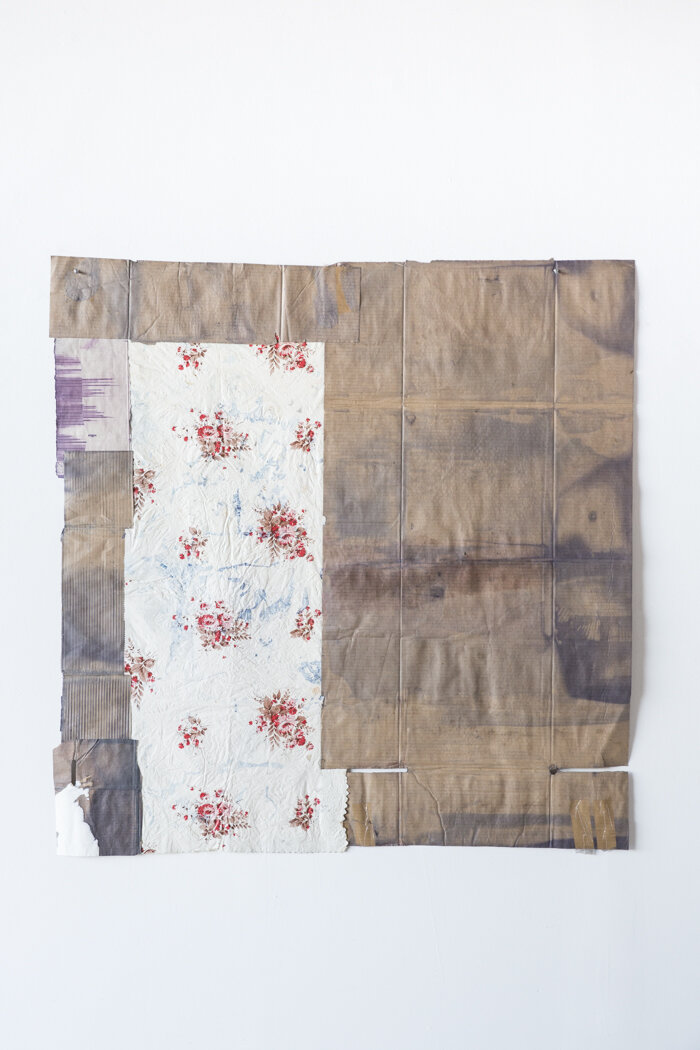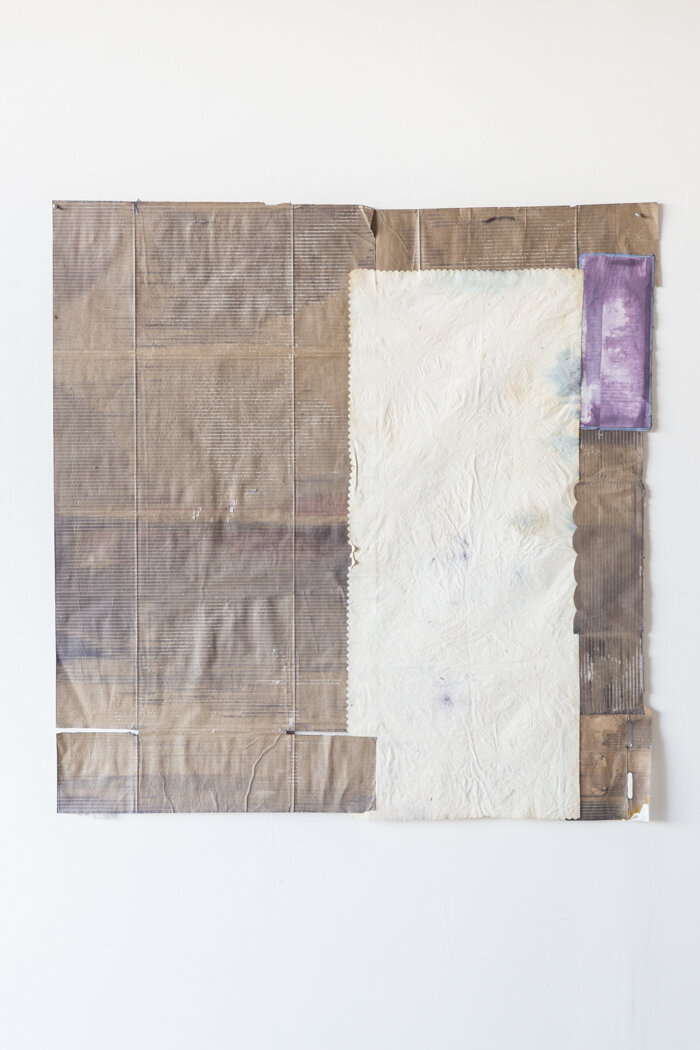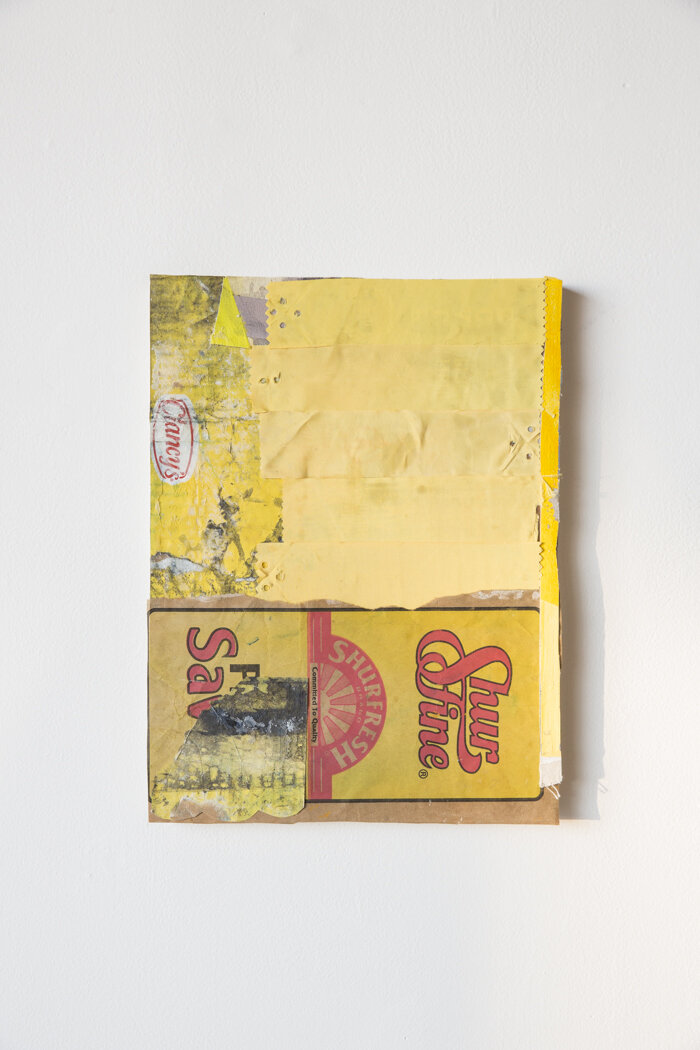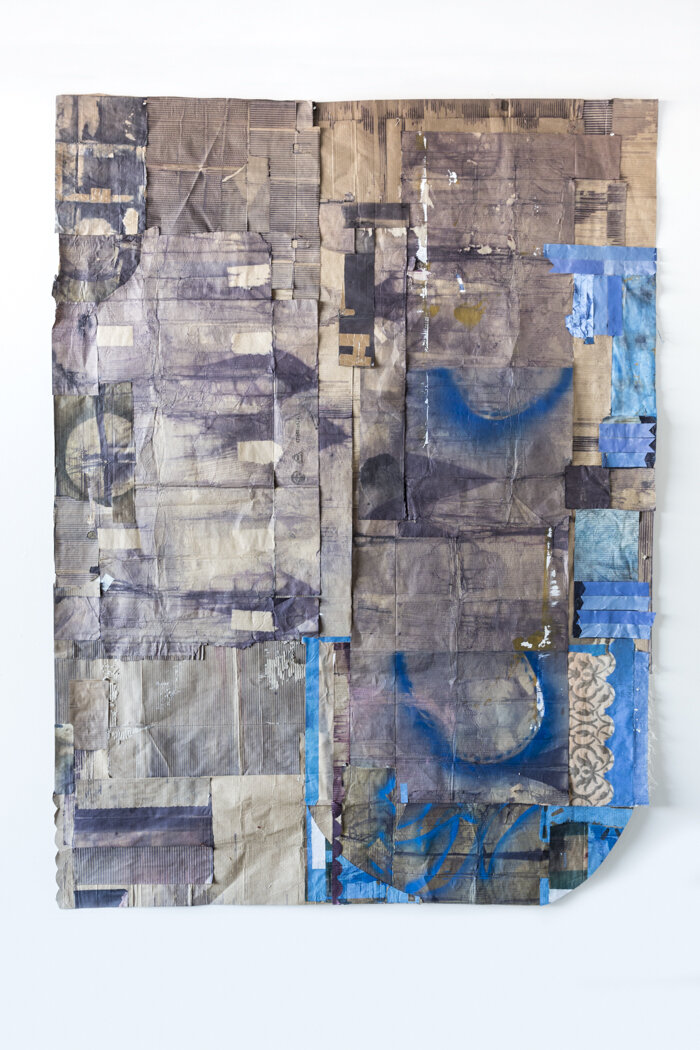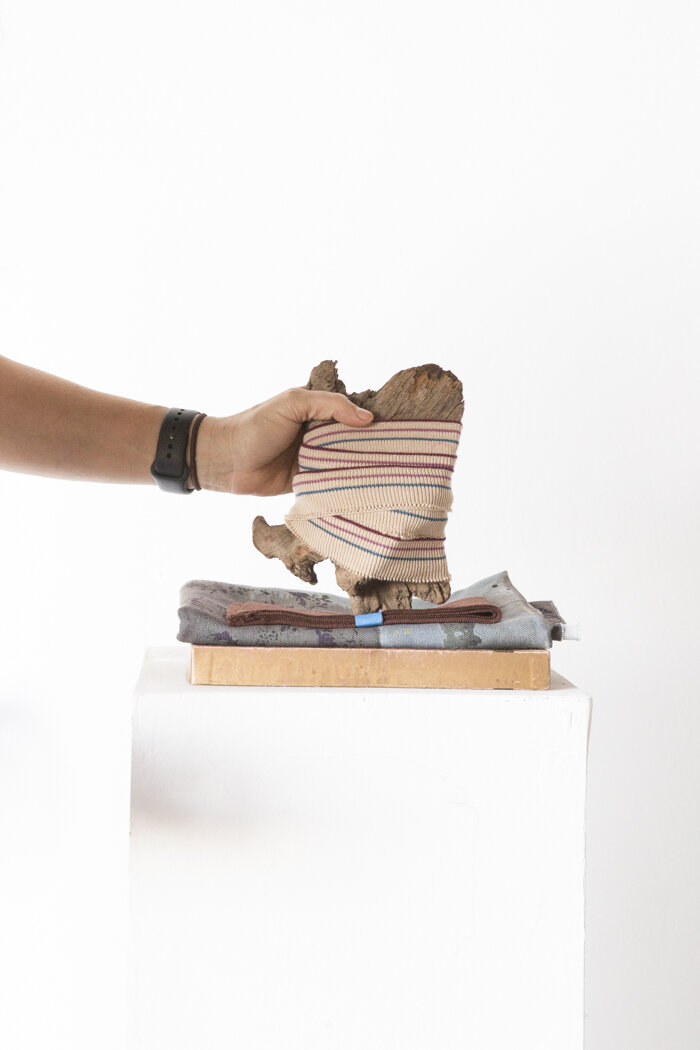Montage can seem to self-contradict—familiar materials’ oft-repurposed to be unfamiliar albeit recognizable. Changed but the same. Akin but different. So too is memory teased by an interplay of expectation and recontextualization; connection seemingly far reached now at once within grasp. This highly-personal creative endeavor may yield conceptual results whose physicality can manifest only within a composition, the result of overlapping ideas best articulated palpably. Jodi Hays’s montages are visual poetry.
Nashville-based, Hays is an artist who grew up in the American South. Her artwork weaves aspects of subjective narrative within a greater cultural context that includes, but is not limited to, regional sociopolitical and historical foundations, modern and postmodern art theory, and peer conversation. By incorporating materials such as reclaimed textiles and cardboard with conventional art media, Hays conceives of abstractions that sensitively articulate how context is inextricable to her process. Though stagnant in its materiality, Hays’s art exudes a momentum of intellectual curiosity and aesthetic bravery. Multi-layered in their construction, these works lend themselves to storytelling, to enticing viewers to both unpack the motivations behind her material selection, geometric structure, and varying form, as well as delve further into one’s own narrative. The following interview with Hays addresses some of these topics, while also discussing how the artist handled the pandemic, and what is to unfold over the course of 2021.
What is your earliest memory of your burgeoning interest in art?
I played on stacks of feed sacks and bales of hay. I collected pine needles and fashioned them into lines, making elaborate house plans with the straw, like inhabited blueprints. My memories of what I began to understand (misunderstand) as “art” are less interesting (yet not unimportant); relegated to paint markers on a yellow school box, crayon on the wall, drawing on my lunch sacks.
How have you witnessed this early interest reveal itself in your current work?
As I came to understand a process independent of an art world definition, I call upon grit, hard work and defiance that often mark those from a rural place.
Tell us about your work. What do you create?
I make abstract work that hinges on my twin loves of painting and materiality. Landscape and the material vocabulary of the American South influence my work. I use reclaimed textiles, fabric, and cardboard in addition to more typical mediums of oil paint, linen, canvas and spray enamel. These materials serve as stand-ins for expressive marks and resourceful labor.
“I make abstract work that hinges on my twin loves of painting and materiality. ”
How has your daily life informed your art making?
My art making is my daily life. The Brooklyn Rail recently ran an interview with Theaster Gates in which he said “ I feel very strongly that I should have a unified life. I'm always living and I'm always making art. I don't stop at 5 p.m.” That is not to say that I do not rest, but resting is the work. Making is the work. Thinking, thrifting, teaching, parenting, painting is all the work.
Your artwork seems to explore the space between assemblage and keen abstract painting—keen meaning that your sense of form reflects knowledge of abstraction’s history. How does the materiality of non-traditional art objects inspire your creative process?
Thank you! There is something improvisational in using materials that one finds in the periphery of a tradition, a convention, a history or a market. I also find “humility of materials[1]” deeply personal (therefore political).
Inversely, how does abstract painting inform your work?
I am a student of painting, which of course includes abstraction, minimalism, high Modernism and design. I am interested in Gerhatd Richter’s ambivalence, Anne Truit’s “Southern Elegy” (among others), the grid of a tobacco basket, and the conceptual implications of all of it.
Who and/or what are some of your biggest artistic influences? How? Why?
My influences are rangey and are not dependent on vocation. Eva Hesse has been a touchstone for decades for her true north compass. More recently, in my last trip to New York (February 2020) I saw a Romare Bearden collage show at DC Moore that continues to impact my practice for their skillful composition, clarity, restraint, scale and palette. Those are just two of the grands[2]. I subsume the words of CD Wright, the late fellow Arkansan, poet and intellectual. Though I did not see the recent show at BAMPFA, I have the Rosie Lee Tompkins (also, Arkansan) catalog.
How does your work demonstrate departure from the above influences?
I like to call my work “sentiminimal.” While I appreciate and ground my work in conversation on what shape and form can do, I also invite an expression and emotional cleave that can inhabit pure design. In often using found or used materials the work becomes a solution for how these vocabularies can unify, forming a new language.
“I like to call my work ‘sentiminimal.’”
How has your art making changed while in quarantine/during 2020 (if at all)?
My studio is in my backyard, so I was able to manifest an uptick in production. My time, though not by any stretch “free,” was immersive, my practice seasoned and I enjoyed some unexpectedly large gains with materials, paper and fabric.
Would you say you were able to make breakthroughs with your work that may not have happened if it wasn’t for the sociopolitical climate of our country over this past year?
Elapsed time will be helpful to better understand all we have been through collectively and how that moves the needle for my work, personally. There were several factors that have contributed equally to what I would call some significant breakthroughs in my practice in 2020, which I recognize as being very bizarre timing. Anne Truitt mentions that when conception happens, you welcome it. So I did, in the very early hours, daily.
That being said, in early quarantine I taught on an online art teaching platform called studioELL. My friend John Ros (NY) developed it years ago, ahead of the curve (there are quite a few that had cropped up by the time 2021 rolled around). I took his course on collage to better get to know the mechanics of the platform. I worked alongside other professional artists, culling and sorting of materials in the home, infused with my love of formal issues, it just caught fire. I took an additional course with Azikiwe Mohommad. I was also mentoring in the Crit Crew for Artist Mother Podcast.
Artwork from John Ros’s quarantine studioELL course, April 2020.
What method would you prefer one take when making a critique of your art: a formal, contextual, or expressive approach? Why?
I enjoy when someone can see the work in its totality and not as either/or. To quote Jack Whitten, “It is very important for me not to separate idea from content from process. The painting must always be seen within the context of forming. The painting is not an illustration of the idea.” I prefer that a writer see the work in its totality, not either/or, but all.
What insights or realizations, if any, do you hope your viewers will understand when they observe your work?
I don’t want to be prescriptive, but I always love going to see a show that makes me want to immediately get back to my studio and make. I’d be nice if my work could do the same for others.
What are some aspects of your work that may not be evident to your audience based solely on its surface/appearance?
I entered abstraction through the back door. I could not make it without Matisse’s Piano Lesson, Richter’s landscapes, Tuyman’s Condoleeza (back at that spot in old MoMA), the heft of Hesse, the certitude of Celmins. I couldn’t expand the field without having camped out in the field for a long time. Thanks to Alma Thomas, Michelle Grabner, Agnes Martin, Beverly Buchanan, and Rosie Tompkins. I see my work in conversation with peers as well, friends like Barbara Campbell Thomas, Karen Dana, Allison Reimus and Vadis Turner, and also Joanne Greenbaum.
“I don’t want to be prescriptive, but I always love going to see a show that makes me want to immediately get back to my studio and make. ”
What upcoming projects and/or exhibitions do you have planned within the next 12 months?
I am in the middle of a collaboration/conversation with Ayanah Moor for Intermission Museum, show is in June 2021. I am headed to a residency this summer at Trillium close to Black Mountain College, as well as to the border of Texas for an artist retreat. There are several group shows in which my work will be included, in addition to a two-person in January at Red Arrow Gallery. I think an exciting solo show is in the works, but I can’t say yet cause I don’t want to jinx it.
What are your goals for your art within the next 12 months?
I have yet to show any of the large scale work from 2020 and this year, so I suppose some of my work is to manifest that. At the residency I will enjoy some solitude, which has been impossible this past year. I will be working towards a few exhibitions, both solo and two person, which means a lot of decisions have to be made regarding post-production, installation, shipping, etc. Though I do set goals, I am in this whole thing for a lifetime.
Non-art question time: What’s your favorite food and drink?
Food made by others with love. Most any drink (but a Stanley Tucci Negroni will do) on a porch or balcony at golden hour.
Band(s) and/or record(s)?
This question gives me stagefright. It always does. I get really self-conscious in ways that I don’t when I talk about my work. After all, I have so many friends that make their living by playing out, touring or supporting the music industry. When I am in the studio, I listen to a very occasional podcast and NPR’s new Nashville music station (91.1). But I find that silence is my favorite, it gets me deep into something special. I suppose I also listen to birds outside my studio, and have become a novice birder (putting out seeds, growing sunflowers to attract Goldfinch).
Movie(s)?
Ted Lasso made me laugh this year.
Money’s not a factor, you will burn no social bridges, and you’re guaranteed a comfortable lifestyle no matter what—where would you live, and what would you do?
As CD Wright says “I am fairly aware of the contradictions in my work and personality. I’m country but sophisticated. I’m particular and concrete, but I’m probing another plane...there are many times when I want to hammer the head. Other times I want to sleep on the hammer.”
So I would split my time between the hills of Arkansas with several A-frame cabins with a giant studio in the rear and a place in New York to rest my traveling head and visit museums.
Anything else that you’d like to add?
Orange Flip. That’s my favorite lipstick color, via my late maternal grandmother (and after whom I am named), Melba Allen Wright.
To learn more about Jodi Hays and her work, please visit her online at www.jodyhays.com and at her Instagram page @JodiHaysPainter. Hays’s work can be seen at the Red Arrow Gallery in Nashville, TN.






